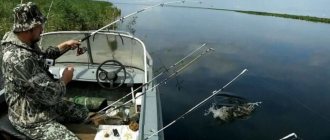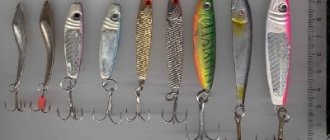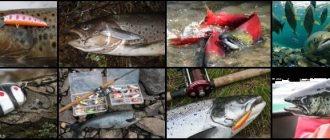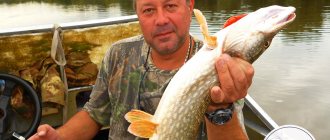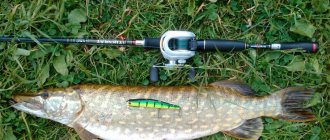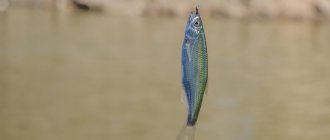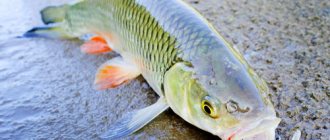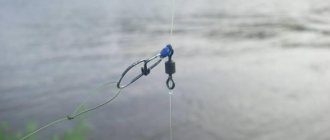A retractable leash, as one of the types of spaced spinning rigs, has been used by domestic and foreign fishermen for quite a long time and everywhere. But most often a jig bait is placed on the outlet (aka Moscow rig), but a wobbler is much less common.
Let's look at the specifics of fishing with a retractable leash with a wobbler. We will also note what types of mounting should be used, we will pay attention to how exactly it is worth catching pike perch, pike and perch on a retractable leash in conjunction with a wobbler and when.
The Moscow rig is a classic spaced-apart spinning rig, where the sinker and bait are attached to different leashes of varying lengths and diameters. The bait is on a longer leash, but closer to the tip of the rod, and the bullet weight is at the blind end of the entire tackle on a short leash.
When it makes sense to install a wobbler on a branch leash - the pros and cons of installation
Schematically, the installation looks like this:
Why in general does the question arise about using a wobbler on what is essentially a jig rig - a retractable leash? There are several important aspects and arguments in favor of this decision:
- The spinner wants to expand the range of use of wobblers - in some cases, the most successful and catchy bait from the entire possible arsenal that is available. It is the outlet that allows you to fish with small wobblers at great depths and long distances, without losing the critical bait in the game.
- Even a small weight allows you to throw a sailing wobbler in windy weather .
- It is possible to painlessly change the working depth of the wobbler specified by the manufacturer . Let's say a certain mine works in a horizon of 1.5-2 meters, but it needs to be driven to 4. This is where the Moscow equipment will come in handy.
- In the current, the wobbler does not push to depth and, if the weight of the load is chosen correctly, it literally combs the bottom without interruption, moving in the working horizon, which is especially important when catching pike perch and large perch, which can stand in a fairly strong current at the very bottom.
- In certain circumstances, a wobbler on a branch is more attractive to predatory fish than a jig, due to the fact that it emits strong vibration. These are, for example, flood conditions, when the water is muddy, on muddy lakes, at dusk and in the dark.
From here we can conclude when it is worth using wobblers in conjunction with the Moscow one. This is the need for long-distance casting of a small wobbler, the need to cast almost any wobbler (not just a diver) at medium/great depths, especially if such conditions are combined with the fact that it is not possible to attract a predator to other baits - summer complete passivity, fishing in the spring in muddy water, or in low light at dawn.
Of the minuses, the following is worth noting - due to some clutter and redundancy of the equipment, the tees of the wobbler often cling to the leash with a load or the main fishing line. To avoid this, we recommend using long bait leads, removing the rear tee and, of course, using a casting technique - it should be biting and sharp.
Jig mounting
For fishing on a retractable leash, baits mounted on an offset hook are most often used:
- twisters,
- vibrotails,
- silicone worms,
- octopuses,
- frogs.
In order to make a rig for fishing with rubber, you will need :
- 1 or 2 swivels;
- a piece of monofilament or fluorocarbon for making the leash itself (most often leashes with a length of 1-1.5 m are used);
- sinker with an eye (a drop weight will do).
Mounting a wobbler on a retractable leash: how to tie the bait
To equip the Moscow equipment, you must have in your arsenal:
- stick weights or the like;
- fluorocarbon;
- swivels;
- fasteners;
- wobblers;
- spinning tackle;
- some knowledge and desire.
Installation when using a wobbler is practically no different from that used when equipped with a jig bait. There are several options:
Methods for tying a leash
The figure above shows a diagram of a simple attachment of a leash with bait to the main fishing line. On the left side, as we see in the picture, there is a knot that prevents our leash from coming undone or slipping.
You can also familiarize yourself with the binding option outlined in the following video.
- The simplest and fastest way is to mount the leash to the fishing line with a sliding knot; it allows you to easily change the distance between the attachment point of the leash and the sinker.
- A certain group of anglers prefer to mount the leash with fixed knots, of which there are a great many ways to knit.
Hooks
If fishing takes place in shallow waters, as well as with all kinds of underwater obstacles, then the most suitable hook option is an offset hook. The hook should be the size of the bait, and its end should be sharpened.
What wobblers are used for Moscow equipment
Floating wobblers and suspended wobblers are used. Size and type (minnow, shad, fat) - depending on the purpose of fishing, the size of the predator and its activity.
General tips when choosing a wobbler:
- No matter how good the outlet is, it’s not worth it to go crazy shallow with a wobbler . We'll leave the little ones to the ultralight. The size of baits for perch is 3-6 cm (minnows and cranks), for pike perch 4-8 cm (usually minnows and shads), for pike 5-10 cm (the whole range of shapes and types).
- The wobbler must have good flow, complex and aggressive animation .
- It is highly desirable to have a confident and attractive play on pauses , if with a slow rise - great.
- It is worth using on a retractable leash those models of wobblers that are not applicable in regular casting due to the situations listed above .
- Do not use very expensive wobblers from top manufacturers . In any case, a retractor in combination with a wobbler is not the most passable tackle, and fishing is often carried out in difficult places. Therefore, there will be breaks and to avoid excruciating pain, we use the average price range - Aiko, Spro, Pantun 21, Stayk Pro, Kosadaka, Salma, Tsuribito, etc. They produce relatively inexpensive, but high-quality baits in a wide range. Cheap Chinese do not meet the following criterion:
- They do not have their own game at slow fishing speeds and fall on their side - which is especially critical when fishing for pike, medium and large perch, and passive pike perch in the current.
Pontoon 21 Mojarrilla - 40 mm excellent floating crankshad for perch, chub, small pike - but bad luck flies very poorly, so the diverter will come in handy
With the choice of cranks and shads, the situation is easier - almost all of them have an acceptable or excellent game on a uniform retrieve, stop-and-go, twitching, stretching. More information about cranks for chub (many of them also work for perch) here.
Minnows are more finicky. Among specific models, it is worth noting Strike Pro arc minnow, Kosadka Mirage, Kosadaka Intra, Kosadaka Ion, Tsuribito Dead minnow and many others - often those that are already in the box.
The size range is from 4 to 12 cm. For perch 4-6, for pike perch up to 8-10 cm, for pike up to 12, and sometimes more. Smaller in spring, larger in autumn. The colors are selected based on the same considerations as for conventional wobbler fishing.
A wider choice of a specific model is always up to the fisherman, it is very extensive and varied, but our recommendations for choosing the best wobblers for pike can be studied at the link.
Yo-Zuri L-Minnow - we recommend it as one of the first wobblers for beginners
Trolling Secrets
When trolling with this rig, jig baits are also used: twisters or vibrating tails of a decent size for a predator. But mostly they fish with wobblers, although you can also tie heavy spoons.
The sizes of baits and gear for catching predators are common for trolling, and the loads depend on the depth of fishing and the speed of the current. Naturally, the equipment needs to be made with an increased diameter of the monofilament leader insert, up to 0.27 millimeters.
Installation with a retractable leash allows you to quickly deepen the wobbler to the desired depth and guide it in any layer of water. You need to tie trolling gear for a predator in the same way as spinning gear. Also at the end of the main line there is a weight, and above it, 30-50 centimeters, there is a branch with a jig bait, twister or vibrotail, or wobbler.
Fishing with a wobbler on a retractable leash by casting - who, where and how
Read in detail about fishing for pike, perch and pike perch using the links, but in the context of this article we will go through the features of catching these predators using Moscow equipment in conjunction with wobblers.
It should be understood that the Moscow rig with a wobbler is the last echelon, the last chance to get away from zero and seduce a stubborn and passive predator. Where the pressure from fishermen is off the charts, or on days when the weather is not at all favorable.
In other situations, it’s worth trying just wobblers, jigs, or a retractor with jig baits.
How does a wobbler go on a Tyrolean with even wiring?
How to work with a wobbler on pike
The features of installing equipment on pike have already been discussed in the section above. Here we note such a nuance that pike more often than other fish stands in snags and other “strong” places, and therefore it would be appropriate to use elongated weights that will be tied to a thinner fishing line than the bait leash, so as not to lose all the tackle when hooked.
It is also worth replacing the hooks of wobblers with no thinner ones from Ovner, which bend with powerful tackle, but do not break, plus they cut through the mouth of a toothy beast well.
Pike likes to stay in deep places - edges, holes and exits from them, and on reservoirs and large lakes it often stands at the bottom or in close proximity to it.
Classic jig fishing for a drop in depth - a wobbler is not capable of this without a diverter
When fishing with cranks, you can use a uniform dull retrieve, with frequent pauses. Varying their duration. During pauses, a good wobbler hangs and, shaking its sides, depending on the type, slowly floats up, or hangs above the bottom.
The more passive the predator, the slower the retrieve and the longer the pause. You can tweak it a little during pauses.
When fishing with minnows, you need a more aggressive presentation and animation. Twitching with pauses, pulls of different amplitudes and sharpness, small-small dribbling with the tip of the rod in combination with a uniform rotation of the reel handle, as well as a purely jigging step .
This is exactly how often you need to work on pike! The step is jigging and aggressive, with a high lift from the bottom with twitching in combination - only Moscow equipment is capable of this.
The size used is from 5 to 10 cm - the most popular.
Pike often stands at the very bottom; in such cases, a variation of the outlet leash, the so-called Tyrolean stick, is good.
Rigging option on a Tyrolean stick, when wiring is required at the very bottom:
Catching pike perch with a wobbler on a retractable leash
If you are fishing for pike perch on a clean, hard bottom, without much snags, then we will not recommend replacing hooks with softer ones, as when fishing for pike on snags and holes. Since it is possible to pierce a fanged hard mouth only with sharp and hard hooks, especially if fishing is carried out at a long distance.
Pike perch often chooses the deepest places available in its habitat and stays near the very bottom. It is for the purpose of finishing it off using a wobbler that a loaded lead is used, due to the fact that even deep-sea wobblers divers will not reach a depth of more than 5-6 meters, and they need appropriate tackle for them - very powerful, but at the same time sensitive.
Therefore, when catching pike perch at depth, it is worth using suspenders with a powerful shovel and loading them with a retractable leash with a load of 20-40 grams, depending on the depth and nature of the bottom.
A retractable leash with a wobbler often helps with passive pike perch, which clings to the bottom at great depths when the jig is silent, and the wobbler cannot be driven to a given horizon in the usual way.
Another situation in which it is appropriate to use the Moscow one is when the wiring is done against the current, and the wobbler has a small blade that has a small angle of attack of 70-90 degrees. This will be squeezed out onto the surface, which will not make it possible to make normal working wiring.
On how to catch pike perch on a retractable leash (not on wobblers, but the basics of application are not particularly different):
How to use a retractable leash with a wobbler for perch
For perch, the whole range of both baits used and types of fishing is possible. It all depends on where it is currently standing, at what depth, and what its size is. Read more about how to catch perch on a retractable leash in general.
The more active the sailor, the more aggressive the wiring should be. The perch really likes the uniform movement of pot-bellied cranks with small pauses. You can try to tempt the predator by pulling crankbaits at the bottom. Often bites occur precisely in the active phase of animation.
Minnows are twitched in a classic way, there is not much difference in comparison with the classic twitch minnows for perch.
Note that the minnow catches larger perch and is more passive than the crankbait. From this, practical advice when catching perch on a retractable leash with a wobbler is to use cranks on an active perch evenly with pauses, on a passive minnow with various types of twitching and other animations.
It is interesting to catch small and medium-sized perch using microwobblers with a retractable leash; this allows, firstly, to throw a small and light bait tolerably far, and secondly, then drive it to at least some depth. This is especially important if there is no ultralight tackle, and the situation dictates the need to use the smallest wobblers weighing 2-3 grams.
Where and when used
A lot of gear is made using bends. Moreover, this applies not only to fishing in spring or summer, but also applies in winter. Let us list the fishing methods and equipment in which it is used.
- Spinning. The term “retractable leash” is used here, denoting one of the rigs for jig-spinning; it is also called “Moscow rig.”
- Feeder. The retractable leash is used in the construction of the “helicopter” tackle.
- Fishing wiring. Here, a diverter leash is used for fishing in fast rivers with an overgrown or rocky bottom, when it is impossible to carry conventional gear.
- Winter fishing rod with a retractable leash. In the current it is used as a feeder “helicopter”, and in a still body of water it allows you to speed up the fishing process due to the use of a large load.
- Trolling. Fishing fish sites, when you need to place the bait just above the grass, will also be more effective with a diverter mount. The same installation is used when trolling at great depths.
The diversion is used on lakes and reservoirs, on small ponds and on large rivers.
Now let’s take a closer look at the listed options, tell you how to tie this equipment for different fishing methods, and give advice to novice anglers on using the equipment when fishing from a boat or shore.
Trolling on a lead with a wobbler: selection, feeding, wiring
When trolling, it is extremely important to keep the bait, in our case a wobbler, in a given fishing horizon. For this purpose, avid trollers use expensive and complex devices - riggers, bouncers, sinkers, etc.
Bouncer is a trolling device somewhat reminiscent of a trolling stick or a Tyrolean stick.
But they are not always at hand, especially for an “ordinary” spinning player who works 99 percent of the time when casting. Yes, and they are expensive and there is no time and no need to understand how it all works if you are not going to purposefully troll.
Let's say, a Scotty downrigger costs 15,000-20,000 rubles, and the equipment on the outlet in the classic form, or in the form of a clip, will cost 50-200 rubles.
But what to do if conditions dictate the use of trolling, and you have a boat with gear at hand? In this case, you can use a diverter with a wobbler.
If you have deep-sea divers in your arsenal, and the fishing depth does not exceed their working horizon, then using a weight does not make sense. But more often than not, places where trolling is basically possible have a depth of 5 meters or more, and there are only a few wobblers with such a depth, and not all of them have them in boxes. It is also worth considering that if it is necessary to use a catchable wobbler with a small blade in the current, then in any case it will be squeezed out to the surface without additional loading.
Another option for a purely trolling lead with a wobbler is a cargo clip:
One of the options for trolling on a branch with a wobbler, when a jig bait on a jig head is used as a load:
Leash with triple swivel
This type of equipment is good because at home you can make several different rigs with different hooks and weights, reel them on a reel and easily change them while fishing, each time choosing the best option for specific fishing conditions.
The installation of a diverter leash with a triple swivel looks like this:
- a triple swivel (2) is tied to the end of the main line (1);
- a leash is attached to the middle eye of the triple swivel, at the end of which a sinker is attached (3 and 4);
- A leash with a hook (5 and 6) is attached to the third eye of the swivel.
Tackle used
When fishing with a wobbler, you should use a clear and clear form with a fast action.
The test is selected based on fishing conditions = required sinker weight + wobbler weight + 20 percent reserve. Calculation example. It is planned to fish at a depth of 6 meters with a slow current at a distance of 30-40 meters. A sufficient load in such conditions is around 14-16 grams. Plus a crank weighing 8 grams. Total 22-24 grams. With a reserve, this is a rod with a test weight of 15-35 grams.
The fishing line is either braided, but with a flur shock leader to avoid wear of the braid on an aggressive environment (sand, stones, branches), or fluor as a base entirely. Monoline is not suitable in most cases - it is weak for wear, not as sensitive as a cord - it does not convey animation, bite, hooking clearly enough.
A fairly long spinning rod is required, since the overhang of the bait leash can be quite large. Let's just say the optimal length is 2.2-2.5 meters.
The reel for braiding is a spinning reel according to Shimano 2000-2500 with ideal cord laying and no loop reset during twitching. Otherwise, fishing will turn from pleasure into hell. With fluorocarbon it is better to use a multiplier reel; it works better with fluorescent 0.2-0.5 diameters.
Is there any prospect for the Moscow equipment in combination with a wobbler? Undoubtedly. It is important to understand under what conditions this equipment should be used. A diver with a wobbler is an equipment for targeted local fishing of promising places, especially in combination with the passivity of the predator. For an active predator, it is better to use methods that allow you to more quickly identify feeding fish over a wide area of water. In such a situation, we use jigs, spoons, and regular wobblers.
It's nice to try, evaluate and understand something new and not the most popular. Fishing with a wobbler, which is loaded with a weight, but on a separated leash, is exactly such a case. Try it, you won't regret it.
Wiring Technique Tips
Fishing with a retractable leash will be successful if you follow the fishing rules and the advice of experienced spinning anglers. Depending on the time of year and the object of hunting, three main methods of wiring are used.
- Posting with swinging of the rod. Evenly winding the fishing line, raise the tip of the form and lower it. This technique is used in the summer and helps catch inactive fish. This wiring is especially good when fishing for perch.
- Uniform wiring. Works great against active predators. This technique can be used in the spring with clearing of the water before fish spawning, and in the fall until frost in October-November.
- Stepped wiring. As with a regular jig: 2-3 turns and pause until it touches the bottom, then repeat. Can be used all year round and on any predator.
Of course, these fishing methods need to be combined; elements of twitching can be introduced, mainly when using wobblers. Also, fishing with a retractable leash can also vary in the direction of moving the bait from side to side. Perches are especially fond of the darting wobbler; they gather in flocks for zigzag fishing.
Fishing with a retractable leash in the current
When using a diversion leash in a current, it is important to use a demolition leash. The technique for doing it is as follows:
- The equipment is thrown perpendicular to the direction of the flow
- Next, the bait and sinkers are pulled by the current until they are carried away in an arc parallel to the coastline
- When stretching the cord along the shore, the equipment is reeled out using any type of wiring
This method allows you to fish fairly large river areas without much effort and find even a passive predator
